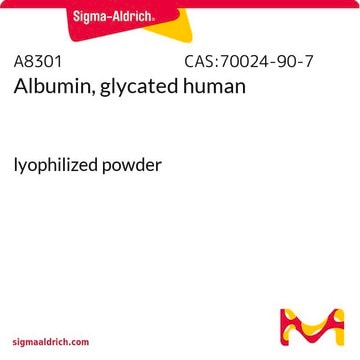The stability of this product in solution has not been evaluated. Generally, peptides should not be stored in solution for extended periods. Should solution storage be necessary, storing aliquots at -20°C is suggested. Note that peptides have a tendency to stick to plastic containers upon storage.
Kluczowe dokumenty
G9145
[Leu15]-Gastrin I human
≥95% (HPLC)
Synonim(y):
[Leu15]-HG-17, LHG-17, [15-Leucine]-Gastrin I, human heptadecapeptide, [18-Pyroglutamic acid, 32-leucine]-Big gastrin I-(18-34)-peptide amide, human, [Leu15]-Gastrin I, human, [Leucine15]-Gastrin I heptadecapeptide, [Leucine15]-Little gastrin I
Wybierz wielkość
427,00 zł
Wybierz wielkość
About This Item
427,00 zł
Polecane produkty
pochodzenie biologiczne
human
Poziom jakości
Próba
≥95% (HPLC)
Formularz
powder
metody
cell culture | mammalian: suitable
numer dostępu UniProt
temp. przechowywania
−20°C
ciąg SMILES
CC(C)CC(NC(=O)C(Cc1c[nH]c2ccccc12)NC(=O)C3CCCN3C(=O)CNC(=O)C4CCC(=O)N4)C(=O)NC(CCC(O)=O)C(=O)NC(CCC(O)=O)C(=O)NC(CCC(O)=O)C(=O)NC(CCC(O)=O)C(=O)NC(CCC(O)=O)C(=O)NC(C)C(=O)NC(Cc5ccc(O)cc5)C(=O)NCC(=O)NC(Cc6c[nH]c7ccccc67)C(=O)NC(CC(C)C)C(=O)NC(CC(O)=O)C(=O)NC(Cc8ccccc8)C(N)=O
InChI
1S/C98H126N20O31/c1-49(2)38-68(115-96(147)72(43-55-46-101-60-19-12-10-17-58(55)60)117-98(149)74-20-13-37-118(74)77(122)48-103-86(137)61-25-31-75(120)105-61)93(144)111-66(30-36-82(131)132)92(143)110-65(29-35-81(129)130)91(142)109-64(28-34-80(127)128)90(141)108-63(27-33-79(125)126)89(140)107-62(26-32-78(123)124)88(139)104-51(5)85(136)113-70(41-53-21-23-56(119)24-22-53)87(138)102-47-76(121)106-71(42-54-45-100-59-18-11-9-16-57(54)59)95(146)114-69(39-50(3)4)94(145)116-73(44-83(133)134)97(148)112-67(84(99)135)40-52-14-7-6-8-15-52/h6-12,14-19,21-24,45-46,49-51,61-74,100-101,119H,13,20,25-44,47-48H2,1-5H3,(H2,99,135)(H,102,138)(H,103,137)(H,104,139)(H,105,120)(H,106,121)(H,107,140)(H,108,141)(H,109,142)(H,110,143)(H,111,144)(H,112,148)(H,113,136)(H,114,146)(H,115,147)(H,116,145)(H,117,149)(H,123,124)(H,125,126)(H,127,128)(H,129,130)(H,131,132)(H,133,134)
Klucz InChI
CMVMLPDUAGUTOC-UHFFFAOYSA-N
informacje o genach
human ... GAST(2520)
Szukasz podobnych produktów? Odwiedź Przewodnik dotyczący porównywania produktów
Amino Acid Sequence
Opis ogólny
Zastosowanie
Działania biochem./fizjol.
Inne uwagi
Kod klasy składowania
11 - Combustible Solids
Klasa zagrożenia wodnego (WGK)
WGK 3
Temperatura zapłonu (°F)
Not applicable
Temperatura zapłonu (°C)
Not applicable
Środki ochrony indywidualnej
Eyeshields, Gloves, type N95 (US)
Wybierz jedną z najnowszych wersji:
Certyfikaty analizy (CoA)
Nie widzisz odpowiedniej wersji?
Jeśli potrzebujesz konkretnej wersji, możesz wyszukać konkretny certyfikat według numeru partii lub serii.
Masz już ten produkt?
Dokumenty związane z niedawno zakupionymi produktami zostały zamieszczone w Bibliotece dokumentów.
Klienci oglądali również te produkty
Produkty
Human pancreatic cancer organoid biobank (PDAC organoids) with various KRAS mutations to aide in 3D cell culture and cancer research applications.
-
After preparing aliquots, what is the stability of this product at -20?
1 answer-
Helpful?
-
-
Is this product also suitable for use with other mammalian species, such as mouse, for ex vivo tissue studies, as opposed to just human organoid culture medium?
1 answer-
The product's validation for batch release does not currently cover murine ex vivo tissue testing. However, the following citations may provide insights into its application for ex vivo non-human samples:
Sci Adv. 2023 Nov 17;9(46):eadh0322. Title: Inactivation of the tumor suppressor gene Apc synergizes with H. pylori to induce DNA damage in murine gastric stem and progenitor cells PMID: 37967175
Infect Immun. 2016 Sep 19;84(10):3083-91. Title: Intestinal Enteroids Model Guanylate Cyclase C-Dependent Secretion Induced by Heat-Stable Enterotoxins PMID: 27481254
Helpful?
-
-
I am interested in this product. A colleague uses it for human organoid culture medium. However, I work with murine ex vivo tissues. Is this also applicable for other mammalian species (so mouse in stead of human)?
1 answer-
This product has not been tested for use with murine ex vivo tissue. However, the following citations may be of interest for its application in ex vivo non-human samples.
Sci Adv. 2023 Nov 17;9(46):eadh0322.
Inactivation of the tumor suppressor gene Apc synergizes with H. pylori to induce DNA damage in murine gastric stem and progenitor cells
PMID: 37967175
https://pubmed.ncbi.nlm.nih.gov/37967175/Infect Immun. 2016 Sep 19;84(10):3083-91.
Intestinal Enteroids Model Guanylate Cyclase C-Dependent Secretion Induced by Heat-Stable Enterotoxins
PMID: 27481254
https://pubmed.ncbi.nlm.nih.gov/27481254/Helpful?
-
-
この製品の溶媒は何を用いればよろしいでしょうか。水またはPBS(-)には溶けますでしょうか、あるいはDMSOでしょうか。
1 answer-
This product is tested for solubility at 1mg/ml in 0.1% NaOH or 1% NH4OH. Other solvents have not been evaluated.
Helpful?
-
Active Filters
Nasz zespół naukowców ma doświadczenie we wszystkich obszarach badań, w tym w naukach przyrodniczych, materiałoznawstwie, syntezie chemicznej, chromatografii, analityce i wielu innych dziedzinach.
Skontaktuj się z zespołem ds. pomocy technicznej








![[Leu15,Gly18]-Gastrin2-17](/deepweb/assets/sigmaaldrich/product/images/384/185/d3095ca6-fe9a-4e1c-b2e9-29ad2bd40c46/640/d3095ca6-fe9a-4e1c-b2e9-29ad2bd40c46.jpg)
![[Gly18]-Gastrin 1-17 human](/deepweb/assets/sigmaaldrich/product/images/973/112/79e0734e-033a-4a31-9368-b08610cdcfd1/640/79e0734e-033a-4a31-9368-b08610cdcfd1.jpg)




